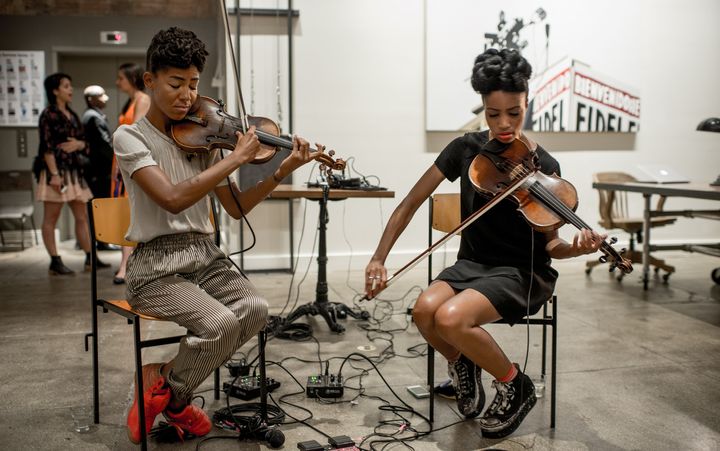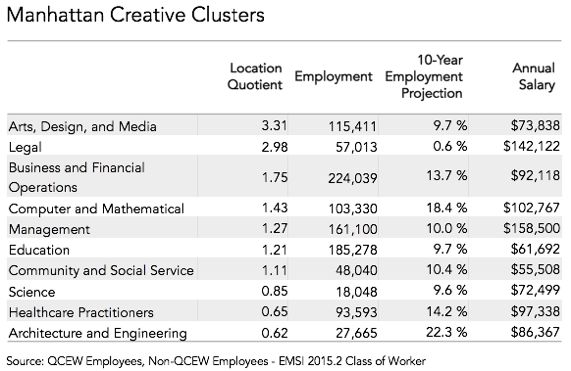
New York has long been recognized as America’s creative capital, fueled by a growing pool of creative talent.
Today, New York City’s Creative Class—workers who have skills in finance, law, science, engineering, art, design, entertainment, and academia—numbers 1.4 million, or 36 percent of the city’s workforce. Back in 2012, former NYC Michael Bloomberg wrote in the Financial Times that “talent attracts capital far more effectively and consistently than capital attracts talent.” This statement has never been more true. Across the country, cities with a greater share of Creative Class workers have higher incomes, wages, and rates of innovation.
But where does New York City’s Creative Class live and work? What is the future outlook for the nation’s creative capital?
To answer these questions, my colleague Richard Florida from the NYUSPS Schack Institute of Real Estate Urban Lab and I took a deep dive into the Creative Class structure of New York City’s five boroughs: Manhattan, Brooklyn, Queens, Bronx, and Staten Island. Our work revealed that New York’s Creative Class extends far beyond Manhattan into its outer boroughs as well. Over the course of the next few weeks, we will share our findings for each borough, beginning with Manhattan. (Our full report can be found here.)
Manhattan’s Creative Class
Nearly 40 percent of Manhattan workers—just over a million—are members of the Creative Class. This number is expected to grow by an estimated 11.8 percent over the next decade. On average, Manhattan’s Creative Class earns $96,970 annually, boasting some of the nation’s highest earners.
Although finance and technology occupations make up a large portion of Manhattan’s Creative Class, creative workers with skills in law, healthcare, arts, and engineering have contributed significantly to the city’s recovery. The chart below breaks down each creative cluster by employment, ten-year projection, annual salary, and location quotient—a measure that compares a geography’s share of creative workers to the share for the entire nation.

With nearly 225,000 employees, Business and Financial Operations is by far the largest creative cluster in Manhattan, exceeding the national average by 75 percent. Certain financial occupations in Manhattan like personal finance advisors and securities, commodities, and financial service professionals are five to seven times more concentrated than the U.S. average.
Manhattan’s Education cluster accounts for more than 185,000 employees and is anticipated to grow by 9.7 percent in the coming decade. This is critically important as New York continues to position itself as an idea capital, with its host of strong academic institutions.
The arts are critical to Manhattan’s creative economy. Manhattan’s Arts, Design, and Media cluster is 331 percent more concentrated than the U.S. average. The strength of this cluster can be largely attributed to the borough’s expertise in advertising, media, fashion, film, and theater. Manhattan’s share of fashion designers, for example, is more than 15 times the national average. Its share of art directors, producers and directors, actors, costume attendants, and so on are all more than nine times greater than the U.S. average. This cluster is expected to grow by 9.7 percent in the next decade.
With over 103,000 employees, Manhattan’s Computer and Mathematical cluster is the fuel behind New York’s recent startup and venture capital growth. As of 2016, New York was attracting 5 percent of global venture capital ($2.1 billion, ranking 4th in the world), the majority of which was concentrated in Manhattan, according to a report from Martin Prosperity Institute. Over the ten years, Manhattan’s Computer and Mathematical cluster is projected to grow by 18.4 percent.
The rest of Manhattan’s creative skills clusters are smaller than the national average. For example, the borough’s Healthcare sector, which contains 93,593 employees, poses a significant deficit for a city that is expected to see its population grow to more than 9 million residents in 2040. With just 18,048 employees, Manhattan’s Science sector is the smallest of any Creative Class occupational cluster.
Who Lives in Manhattan?
As Manhattan’s real estate prices continue to climb, its service and blue-collar workers, along with many members of its Creative Class, are being priced out. While the vast majority of New York’s Creative Class works in Manhattan, only about half of Manhattan’s creative workers live in the borough, according to our analysis of data from the U.S. Census. Nearly six in ten Manhattan residents who work—around 503,000 people—are members of the Creative Class. A large share of creative workers who can afford to live in the borough are employed in Management or Business and Financial Operations. Together, these two occupational groups comprise 43 percent of the borough’s creative residents.
While tech employment is growing in Manhattan, Computer and Mathematical workers tend to live elsewhere. Only three percent of Manhattan residents—approximately 26,000—are computer or math professionals. Surprisingly, 11 percent of Manhattan residents—nearly 80,000—work in Arts, Design, Entertainment, Sports, and Media. This share is much larger than expected, given the relatively low salaries of these workers. Of course, the share of arts professionals who live in Manhattan pales in comparison to the more than 115,000 arts professionals who work there.
Overall, Manhattan residents are more likely to be attorneys than doctors or therapists. Manhattan residents also include a surprisingly large number of education workers—around 7 percent. This could be due to the fact that colleges and universities frequently provide housing for their faculty members. Finally, less than 9,000 Manhattan residents—around 1.0 percent—are engineers or architects.
Manhattan’s Creative Class is driving force of its economy, and especially its recovery from the Great Recession. Nevertheless, the borough’s ongoing affordability crisis has made it difficult to accommodate many of its creative workers, casting a potential shadow over Manhattan’s creative future.
Follow me on twitter @iamstevenpedigo
